TOTAL BULLGRIT
Dungeon & Dragons
Reviews
These posts have no particular order.
TOTAL BULLGRITDungeon & Dragons
Reviews
|
| Introduction I've been a fan and player of D&D since 1980. I still have
many old D&D books and adventure modules, although I rarely use
them now as anything more than nostalgic reading and sources for game
ideas. This page contains my reviews of those old materials. A1 - Slave Pits of the Undercity Bullgrit |
|
Classic D&D adventure module review In Search of the Unknown, by Mike Carr – Basic D&D, 1979, 1981 Introductory module for character levels 1-3 32 pages plus the separate cover with maps
on the inside
faces. This adventure has 56 numbered areas. Generally, this adventure is a basic dungeon crawl; there is no plot beyond general exploration and fighting and looting. The unique feature of this module is that all the room and area descriptions leave the choice of monsters and treasure placement completely up to the Dungeon Master (DM). The first five and a half pages of the book cover lots of notes and guidance for new DMs: Notes for the Dungeon Master, Preparation for the Use of the Module, Time [how to keep track of], Computing Experience, How to be an Effective Dungeon Master. The next two pages cover the adventure location background, random legends (true and false) the PCs may know about the dungeon, and the general description of the dungeon environs. The adventure background explains that the dungeon, named the Caverns of Quasqueton, was built by two adventurers named Rogahn and Zelligar, “a fighter of renown” and “a magic-user of mystery and power.” The two used the location as a base of operations for a while, but then they disappeared on their last foray. Their dungeon base has been essentially vacant for a time. “If only one had the knowledge and wherewithal to find their hideaway, there would be great things to explore! And who knows what riches of wealth and magic might be there for the taking???” The actual dungeon area descriptions start
on page 8, after
the wandering monster chart. To give you a feel for the dungeon
inhabitants,
here are the wandering monsters: 1-4 orcs
1-2 giant centipedes 1-6 kobolds 1-2 troglodytes 2-5 giant rats 1-2 berserkers All the monsters are listed in the “old school” stat block style: AC 6, HD 1, hp 6, 4, 3, 1, #AT 1, D 1-6 or by weapon, MV 90’ (30’), Save F1, ML 8. There is no boxed text for the DM to read aloud to the Players---the boxed text concept was still a few years from being conceived when this module was written and published. There is no real organization to the room description and information text, so to run the adventure smoothly, the DM would need to either memorize all the text or go through making notes and highlighting information he thinks he’ll need. Most of the rooms have lots of text in many paragraphs, so this lack of organization in the room keys is a weakness of the design. But it is also a standard style in most adventure modules of the time. Each area description ends with “Monster:” and “Treasure & Location:” lines. This is where the DM is supposed to write in his own choice for monster and treasure. The list of monsters and treasures to place is near the end of the book. In the monster list, there are 25 choices but a few are repeated with only the number appearing and hit points differing. There’s probably 15 to 20 different monsters listed. There are 34 treasures listed---no repeats---including coins, gems, jewelry, and magic items. The author says this, in bold, for the monster list: “Important: although there are 25 listings, the Dungeon Master should only use 16-20 of them in the dungeon, placing some on each of the two levels in the rooms and chambers desired. The remainder are unused.” And he says this, also in bold, for the treasure list: “Special note: Even though 34 treasures are listed here, only between 15 to 25 of them should actually be placed in the dungeon by the Dungeon Master. The remainder should go unused. When treasures are chosen and placed, a good assortment of items should be represented: some very valuable, some worthless, most in between.” The dungeon itself is large: two levels, each covering over 400 by 300 feet. There are 56 numbered areas, and almost every one has something interesting about it to give PCs something to look at, mess with, figure out, or just be confused by. There are numerous tricks and traps, secret doors, pools of liquids, statues, a maze of doors, a spiral corridor, and at least one of all the other standard dungeon gimmicks. Pages 26 to 30 contain lists and information on pre-generated characters to be used as PC adventurers or NPC henchmen and hirelings. The only things really pre-generated are the character ability scores. Everything else, including personalities, equipment (including some magic items), spells, and levels is given in lists for random determination. It would probably be as easy to just create a character normally as to use the information in this section to determine and finish one of the pre-generated characters. The last two pages is one full page of information for players including setting info, “Here is the standard background setting for all players to read prior to their first adventure,” and play tips. These play tips are great, and can be very useful even for today’s players: Be organized, cooperate, be on your guard, know your limits, etc. All good stuff. Overall, this adventure is a good idea for new DMs and Players. The guidance at the beginning for DMs and the end for Players is solid and wise. Letting the DM place monsters and treasure is a good way to introduce a DM to creating his own dungeons. But the lack of organization for the extensive text makes this adventure very difficult to run without very thoroughly reading and rereading and making notes before the game. All adventures require, or at least need, the DM to read and understand it beforehand, but every room in this adventure is pretty detailed, with lots of information. The gimmicks (tricks, traps, neat stuff, etc.) in this adventure is great for new Players to experience. Just determining what is in the glass and earthen jars of the wizard’s workroom can fill an hour of first timer fun. Experimenting with the various pools in the room of pools can entertain new Players for another hour. New Players and DMs can get a whole lot of fun and good times exploring this dungeon, but anyone experienced with the base gimmicks of a D&D dungeon may find this old hat. And anyone looking for a plot or story will find little in this adventure to entertain them. Some areas and gimmicks of the dungeon just don’t make sense; anyone expecting or preferring a dungeon layout to make sense for its purpose (current or previous) will find this dungeon frustrating. Bullgrit |
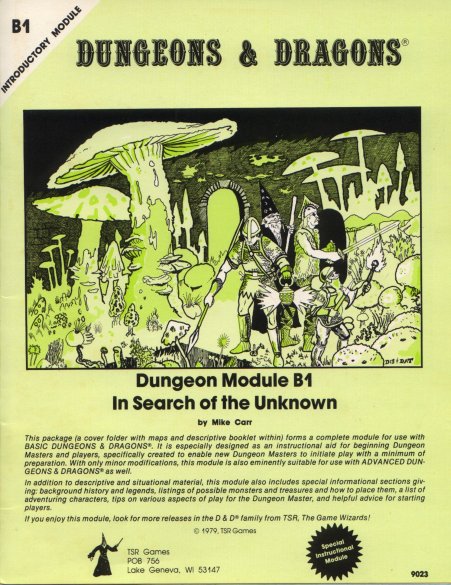 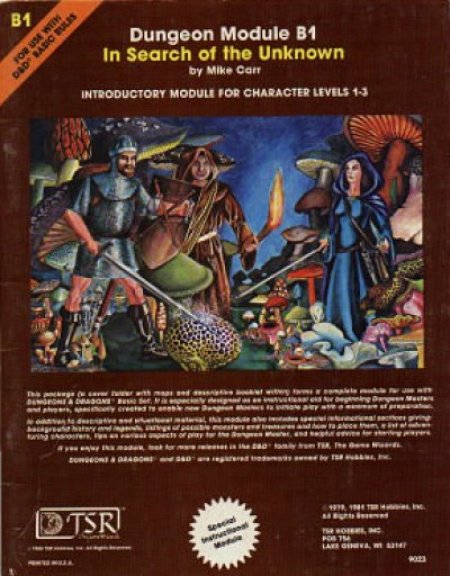 |
|
Classic D&D adventure module review The Village of Hommlet, by
Gary Gygax – Advanced D&D, 1979, 1981 Introductory to novice level. 24 pages plus the separate cover with maps
on the inside
faces. (3 blank pages backing maps.) The adventure has 35 numbered
areas. The first thing you notice about this book is the dense text. Each page is two columns, with small margins, and long paragraphs. There’s a lot of text in this book. The first page is the background for Hommlet and the starting set up for the party entering the area. Hommlet has quite the storied history, being the closest normal town to the Temple of Elemental Evil. The next half page is notes to the Dungeon Master (DM) on running this adventure. The area here, as well as that of the Temple (contained in a separate module), was developed in order to smoothly integrate players with and without experience in the Greyhawk Campaign into a scenario related to the “old timers” only by relative proximity. [The actual Temple of Elemental Evil module wouldn’t be published for another 6 years, in 1985, as the first “super module.” That module would include this adventure, republished.] The biggest chunk of text in this book is the building by building key to the village: eight and a half pages covering 33 numbered areas of mostly mundane buildings and village folk. 6. HOUSE WITH LEATHER HIDE TACKED TO THE FRONT DOOR: This is the home and business of the village leatherworker (0 level militiaman, leather armor, shield, sling, hand axe; 4 hit points). With him live his wife, her brother (a simpleton who does not bear arms), and 3 children of whom the eldest is a 12 year old boy (0 level militiaman, leather jack, buckler, sling, dagger; 2 hit points). The leather-worker is a jack-of-all-trades, being shoe and bootmaker, cobbler, saddler, harnessmaker, and even fashioning leather garments and armor, the latter requiring some time and a number of fittings and boiling. He is not interested in any sort of adventuring. Sewn into an old horse collar are 27 g.p. and 40 e.p. as well as a silver necklace worth 400 g.p. 17. MODEST COTTAGE: A potter is busily engaged in the manufacture of various sorts of dishes and vessels, although most of his work goes to passing merchants or the trader. He has a variety of earthenware bottles and flasks available for sale. The potter (0 level militiaman, padded armor, shield, glaive; 3 hit points), his wife, and four children (two boys are 0 level militiamen, padded armor, crossbow, spear; 4 and 2 hit points respectively) all work in the business. A crock in the well holds 27 g.p., 40 s.p., and 6 10 g.p. gems. They are of the faithful of St. Cuthbert. [Formatting above as it appears in the book.] I cannot see a true need for the amount of
detail such
mundane villagers receive. A few of the villagers are agents of one
side or the
other in the Good and Evil contest, and the text explains them in as
much
detail as the normal folk. Only a handful of the NPCs, those with
levels in a class, are given names in the text. There is a lot of coin and magic treasure in this town. The detail and highlighting of these items, as well as the combat stats of every able-bodied male in the village, suggests perhaps the author expected the Player Characters (PCs) to explore the homes and businesses as they would a dungeon. I can’t believe that was actually the intention, but the information on the village buildings looks exactly what you normally find in a dungeon write up (including the dungeon at the end of this book). A few of the buildings are detailed down to the rooms inside, even with full maps: The Inn of the Welcome Wench tavern (3 floors), the Traders’ Establishment, the Church of St. Cuthbert (3 floors), and the Guard Tower (7 floors). There’s no set adventure to be had in these locales, so scaled maps seem unnecessary. I guess they could be useful for first-time DMs to see what a tavern or church in a D&D world would look like, but I would think illustrations would be better than combat grid maps. The map on the inside of the book cover shows the entire village at 110 feet to the inch scale. The individual building maps cover pages 17 – 22 (one sided pages). For the village of Hommlet, there’s a great deal of individual building and person detail. The adventure site, The Ruins of the Moathouse, located 3 miles from the village, covers pages 12 – 16, with the two-level map on pages 23 and 24. The ruined moathouse “was once the outpost of the Temple of Elemental Evil,” and its ground level is now occupied only by some vermin and a small group of human brigands. The wandering monster encounters are: 2-8 giant rats
(see #13., below) The dungeon level of the moathouse is the true place of Evil in hiding. An ogre, some zombies, gnolls, bugbears, ghouls, and a sizable group of evil soldiers for the Temple of Elemental Evil are all lead by Lareth the Beautiful, “the dark hope of chaotic evil”. The PCs could become heroes for rooting out and destroying this small bastion of dangerous villains. They could also come out quite wealthy. The text of this adventure is dense, with
most of the areas written in single paragraphs. There’s no boxed text
to read aloud
to the
Players, so the DM has to read the information carefully before the
game
session, and probably make notes and highlight information to run the
encounters. As evidenced here and in other adventure modules, this
author tends
to write encounter information in a stream of consciousness
style---description, monsters, and treasure are in a single long
paragraph for
each encounter area, with no set organization. All the monsters are listed in a modified “old school” stat block style: (H.P.: 21): AC 5; HD 5 +1; Move 9"; 1 attack using bardiche for 2-8 +5 (7-13) hit points of damage. The adventure is simple and straight-forward enough for novice players wanting to explore a dungeon and fight evil monsters and men, but the opposition in the dungeon is pretty numerous and strong for a party of 1st-level PCs. Even if the adventurers are themselves numerous (the text does not state how many PCs the adventure design expects), they’ll have to be tactically savvy with a mind to retreat when necessary, if they hope to survive this dungeon delve. Overall, this book spends many pages and much detail on the mundane villagers of Hommlet compared to the adventure. But, the book is titled The Village of Hommlet, so it is actually giving the DM what it advertises. This book is a village, home base source book with a small adventure appended to the end rather than an adventure module. Bullgrit |
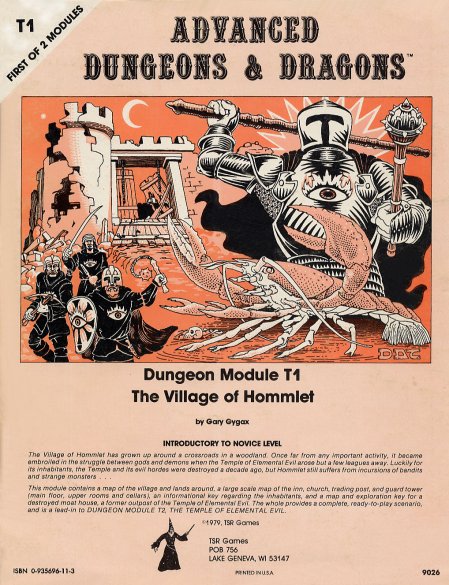 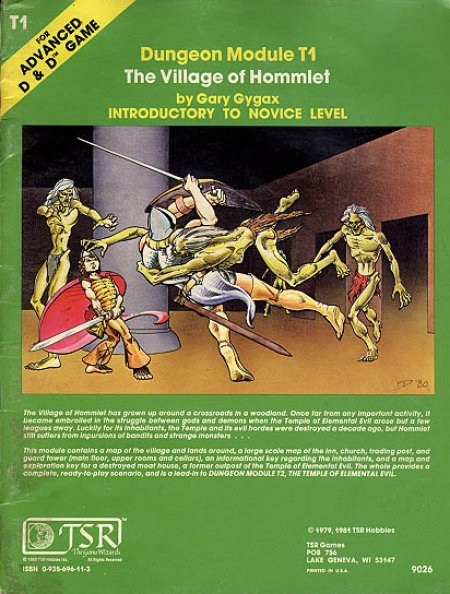 |
|
|
Classic D&D adventure module review The Keep on the Borderland, by Gary Gygax – Basic D&D, 1981 Introductory module for character levels 1-3 28 pages plus the separate cover with maps on the inside faces. The adventure has 64 numbered areas. This module originally accompanied the Basic Dungeons & Dragons boxed set (1981, edited by Tom Moldvay). The first four pages of this module is an introduction to Dungeons & Dragons. There are notes for the Dungeon Master (DM) on reading monster and non-player character (NPC) stats in the module text, on running combats, on tracking time, and some general advice on how to be an effective DM. The background on the setting of the Keep, and the starting set up, including a table of 20 rumors (true and false) the Player Characters (PCs) may know, begins on page 6. The information on the numbered areas of the Keep cover pages 8 – 12. Every structure in and about the Keep is described, and even each person statted out. It’s ironic that with all this detail, no one in the Keep is given a name---even the Keep itself has no name. Everyone from the innkeeper to the castellan is simply referred to by their job title. The areas in the Keep are detailed down to the treasure hidden in personal rooms. The loan bank key includes the treasure stored in the cellar strong room---it’s full of valuable treasure, and would probably tempt most PC parties to at least consider a raid on it if they ever learned of it. Pages 24 and 25 has a list of statted out NPCs, including personalities, advice for designing floor plans for buildings in the Keep, some tips for Players, and a glossary of non-game terms (like brazier and pot boy). Page 26 has a sample floor plan, (for the Keep Guild House), and pages 27 and 28 have a map of the Keep and the wilderness around the Keep, respectively. Four wilderness encounter areas are described over a page and a half after the section on the Keep. The main adventure locale of this module is the Caves of Chaos, detailed on pages 14 – 23. The map for the Caves covers the entire inside cover of the book. The dungeon complex is a moderately large set of caves in a ravine. Eleven entrances each lead to one set of caves occupied by different evil humanoid races, (kobolds, orcs, goblins, hobgoblins, gnolls, bugbears), a few individual monsters (ogre, minotaur, owlbear), and a temple full of undead. Though some readers may have a difficult time accepting so many different and aggressively opposed creatures living in the same relatively small area, the arrangement does allow the invading PCs to take on small chunks of increasingly dangerous tribes, one at a time. If the PCs can determine what creatures live in which caves, they can choose to take on the kobolds first, then the goblins, then the orcs, etc., and work their way up to fighting the bugbear and minotaur when they gain a level or two. This is a good design decision for introducing novice Players to the game---they can encounter a wide variety of monsters in their first adventure. Some of the encounters consist of numerous enemies, and parties of less than the suggested six to nine PCs can find themselves in serious trouble. Like many other adventure modules of this
era, there is no
boxed text to be read aloud to the Players. And like many other
adventures by
this author, the text is written in a stream of consciousness style, so
the
room description, monster combat stats, and treasure is all in the same
paragraph with no organization. A DM must read through the areas before
the
game session to make notes and highlight information, because trying to
read
through it at the gaming moment will get confusing and will slow down
the play. All the monsters are listed in the “old school” stat block style: (AC 5, HD 2, hp 8 each, #AT 1, D 2-8, Save F 2, ML 8). Overall, the adventure is broad selection of monsters for novice Players to experience. There is no stated or explained plot or specific background for the Caves of Chaos, so a DM will either need to make up something for his campaign, or else just hope the Players never wonder about it. With brand new D&D Players, it is quite possible that they may never think or care why there’s all these monsters in the caves, and why there’s a temple full of evil priests, skeletons, and zombies in the same locale. Bullgrit |
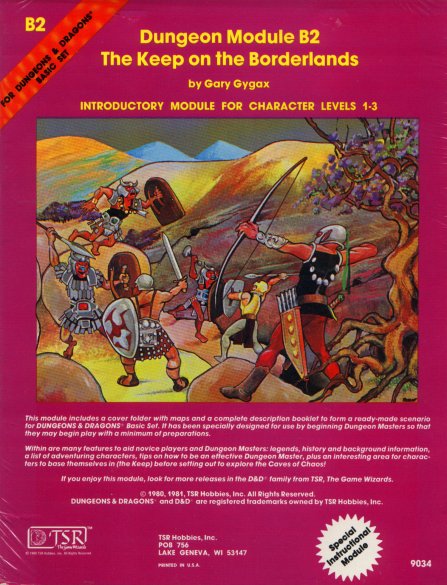 |
|
|
Classic D&D adventure module review The Sinister Secret of Saltmarsh, by Dave J. Browne with Don Turnbull – Advanced D&D, 1981 An adventure for character levels 1-3 32 pages plus the separate tri-fold cover with maps on the inside faces and the third panel of the outside face. (1 blank page backing player handout illustrations.) The adventure has 30 numbered areas in the mansion, and 17 numbered areas on the ship. This was the premiere module from the United Kingdom, and the preface mentions, as a light warning, that American readers will probably notice the “slightly different flavour.” The first four pages introduce the module, mention the town of Saltmarsh, tell the legend of the haunted mansion, and explain the overall plot and story for the adventure. Unlike other adventures of the time period with a town name in the title, this module does not detail the main town. The section on the town merely gives an overview and tells the DM to create any necessary details, including the names and occupations of the Town Council and other prominent citizens, any inn and/or tavern, and the place(s) of worship. The only details given are the population, “about 2,000,” and its coordinate location on the World of Greyhawk map. The plot for this adventure revolves around a supposedly haunted mansion on a cliff near the town. The text gives several plot hooks to get the PCs to investigate the mansion. Once the PCs investigate, they should discover a smuggling operation working out of the basement with its small sea caves complex. When the PCs defeat the smugglers, they will then need to prepare to capture the smugglers’ ship when it arrives. The mansion is not actually haunted, but is dilapidated enough to have a few dangerous spots that act essentially as traps. There are several giant vermin encounters in the mansion, and in a change of the AD&D paradigm, the vermin don’t have deadly poisonous bites. The authors made the spider and centipede bites debilitating instead of killing. This module has boxed text to be read to the Players, and the room information is broken up into readable paragraphs. This helps tremendously compared to other modules of this era with dense paragraphs and no text boxes. All the monsters are listed in the “old school” stat block style: (AC 8; HD 1+1; hp 7 each, #AT 1; D 1 hit point plus poison). The only non-critter encounter in the house proper is with a tied up self-admitted thief. This Ned Shakeshaft is actually an assassin placed in the mansion to foil the PCs’ investigation. The encounter is set up such that Ned has what seems like a good story for his presence, but the story is flawed just enough that proper scrutiny will reveal a clue to actually push the PCs further in their investigation. If the PCs make it to the secret areas of the basement of the mansion, they will find obvious evidence that the house is not vacant. The cavern areas are full of smugglers and some humanoid thugs. This part of the adventure in the mansion can and probably will be a series of combats, hopefully ending in the defeat of the land-based element of the smuggler operation. With the evidence found and deciphered from the mansion investigation, the PCs will need to plan an assault on the smuggler ship. The ship part of this adventure can go in two completely different ways: It can be a stealth operation – sneaking up on the ship, slipping on board, quietly taking out guards, etc. Or it can be a straight-up boarding assault – storm the railings, hack and slash the defenders, etc. The module is written with the assumption that the PCs at least try the stealthy approach first, although a mass melee on the decks may result from mistakes or bad luck. Once the smugglers are defeated and the ship taken, there is more mystery and intrigue to discover: what the smugglers are actually smuggling, and to whom. This sets up the plot hook for the next adventure module in this series, Danger at Dunwater. Overall, this adventure is not a mindless hack-and-slash affair. It is a mystery story punctuated with interesting combat scenarios. There are intriguing plot points throughout the adventure, and the whole operation is full of great role playing opportunities. Impatient, strictly kick-in-the-door types may not appreciate this adventure, but there are enough of most gaming style elements here to satisfy most gamer types. This module is truly one of the greatest adventures ever created. It has story, role playing opportunities, and plenty of grand, interesting combat. Bullgrit |
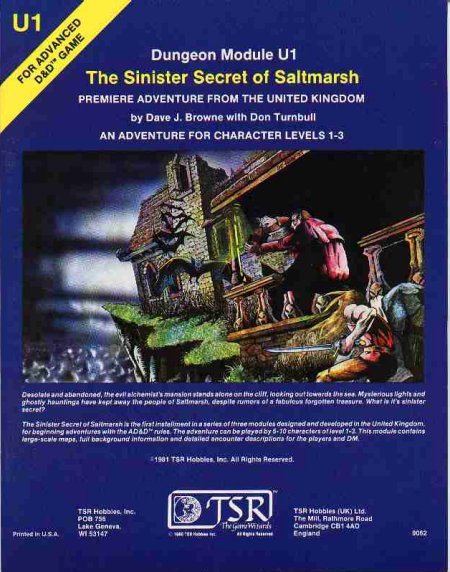 |
|
|
Classic D&D adventure module review Slave Pits of the Undercity, by David Cook – Advanced D&D, 1980 An adventure for character levels 4-7 24 pages plus the separate cover
with maps on the
inside faces. The adventure has over 40 numbered areas on two dungeon
levels, and there
are two new monsters: the aspis (humanoid insects) and the giant sundew
(monster plant). The concept for the module works fine as a
general campaign adventure, but there was no rewriting to make the
overall setting work in a logical way for campaign play. The author
added more rooms and encounters, between and around the limited
tournament encounter areas, but they don't work together in any logical
way. The adventure setting is a ruined temple
being used as a slave depot in the middle of a monster-controlled city.
The biggest omission is any information on the city itself. All the
text gives a DM is: Highport was once
a human city, but the land and town have been overrun by humanoids --
orcs, goblins, kobolds, ogres, and gnolls. Looted, burned, and
ill-kept, the city has become a base for human outcasts wishing to deal
with these unsavory creatures. This description does serve to stir the
imagination, but really, this setting needs more than just two
sentences. This city sounds like a whole campaign setting for
adventure, but the text only offers it as a vague backdrop for the
dungeon adventure. But even the dungeon setting, itself, is
given only a vague description, with the maps showing only part of the
ruined temple. The maps, and the room and encounter text, only show and
describe the main temple proper and the underground passages around
part of the city's sewer system. The maps and text suggest much more
beyond what is shown and explained, but it is up to the DM to figure
out and detail. Most tournament modules were designed for a
party to just be at the first encounter area and to work their way
through the dungeon in a set time limit, and this is acceptable for a
tournament game. But for campaign play, most Player Character parties
don't just magically appear in front of the dungeon, and they don't
complete the whole thing in one day of adventure. Campaign parties have
to get to the location, and probably will have to pull out of the
dungeon to rest and recuperate at least once during the adventure. This
module gives no information or guidance on the greater setting of the
dungeon. This gives details on just two parts of a larger location
in the middle of a monster city. It's like the module author said,
"Here's two levels of a bigger location set in the middle of a monster
town. You can create the rest of the location and the town." The dungeon levels and rooms and encounters
just fail in overall unity. Some of the individual areas and encounters
are quite interesting and challenging, but when looked at as parts
of
the greater whole they are supposed to be, they have no logic or sense.
The overall structure is supposed to be a slaver fort, where slave
buyers come to look at and purchase slaves. But when you look at the
layout, you see that there are no safe routes through the fortress.
There are monsters and traps everywhere, such that it is impossible for
the inhabitants (guard patrols, slave chain gangs, and legitimate
[evil] visitors) to actually get around the place. Wild ghouls, wights, and even basilisks
wander the same halls (as wandering monsters) as orc guards and
slavers. (There's a 4th-level cleric and a 6th-level cleric in the
fortress, but there's no information or indication that they control
the undead.) Ruin Encounter Table (roll d6) And then some of the area encounters,
though interestingly set up, make no sense as a part of the overall
fortress. Taken as separate, set piece challenges, some of the
encounters are fun and clever, but they just boggle the mind when you
consider them in total. I'm sure that tournament players don't have
time or the inclination to think about the fortress as a whole, because
they are just playing to see how far they can get through the
challenges faster than other teams. But in a normal game, campaign
experience, players will notice the stupidity of having encounters
grouped in illogical ways. I ran this adventure twice, a few years
apart, and both times, with different groups, the players started
noticing the wonkiness of the dungeon setting. They started asking
questions of the fortress denizens, and since the module text gives no
help in this regard, I was at a loss to have the NPCs answer the
questions. I mean, questions to orc guards as simple as, "How did you
get into this room?" and "How do we get to the slave pens?" left me
looking at the map and text with a dumb look on my face. As a whole, this adventure module is bad.
The various room encounters read like they were written by different
people with no concept of what the next room was, or what the overall
environment was. A pure hack-and-slash group of players, who don't
think of the adventure beyond the room they are currently attacking may
not cause any problems for a DM. But a group of players who put any
thought into their infiltration plans, or try to conceptualize the
overall layout of the fortress, or try to question the denizens of the
place will cause a DM a bunch of headaches. You could probably mine this module for cool
individual encounters to pull out and drop into other adventures, but
don't try to run this as a logical, unified setting. It's like a bunch
of random room encounters thrown together and connected with
five-feet-wide
corridors. Bullgrit |
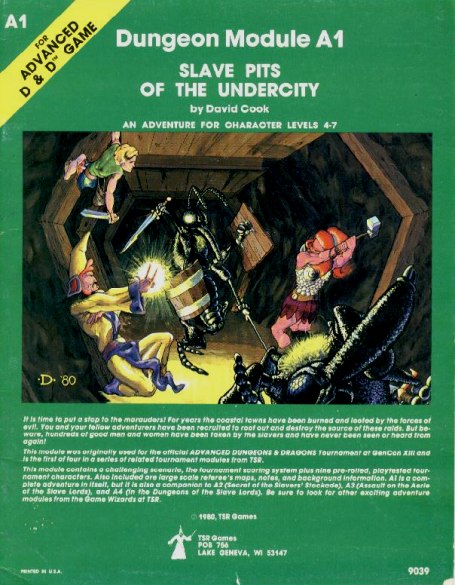 |
|
|
Classic D&D adventure module review Dwellers of the Forbidden City, by David Cook – Advanced D&D, 1981 An adventure for character levels 4-7 At the back of the module are four pages of
new monsters: the first D&D appearances of the aboleth, mongrelman,
tasloi, and yuan ti; and reprints of two creatures from the AD&D1
Fiend Folio: the pan lung dragon and yellow musk creeper. The last page
has 20 pre-generated characters. Parts of this adventure were used in a major
tournament, but this version has been expanded considerably for use in
a general campaign. The tournament parts are the entrances to the city:
underground passages through guards and monsters. But these entrances
are not the only way for campaign PCs to get into the city, and the
module explains the monsters and difficulties for going over and down
the cliff faces. The city is basically a monster-filled
ruins, with no organization or single control. Different sections of
the city are "owned" by different species and factions, but there is
nothing like a city civilization. It's all pure chaos, and walking the
crumbled city streets is like walking down a dungeon
corridor---wandering monsters will attack you (and each other). Only 13 areas are detailed in any way, so
most of the city is assumed to be empty buildings prowled by wandering
monsters. With a creative DM, spending time fleshing out the rest of
the city, this could be a campaign setting to occupy PCs for several
levels. Without fleshing out the "empty" parts of the city, still, the
PCs could spend a few weeks exploring, fighting, and dealing with the
various creatures of the city (all of which are wicked and vicious).
Near the end of the module is a two-page section on "The Forbidden City
In Campaign Play." This gives hooks and ideas for expanding the
adventure.
This module does not need the
DM to expand on it, but the setting concept just begs for it. This adventure is a big concept, and it gives enough content to satisfy, but it is also wide open for industrious DMs to expand upon. Bullgrit |
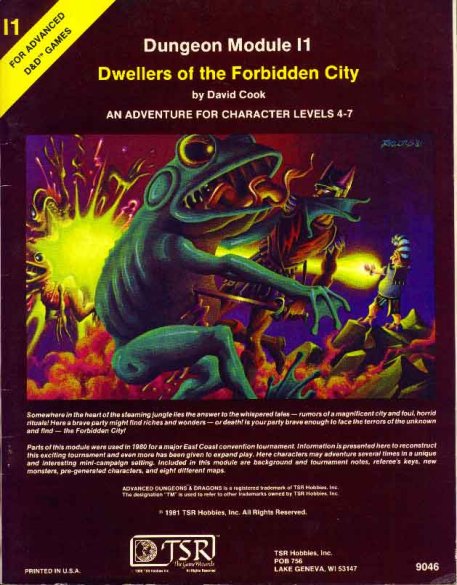 |